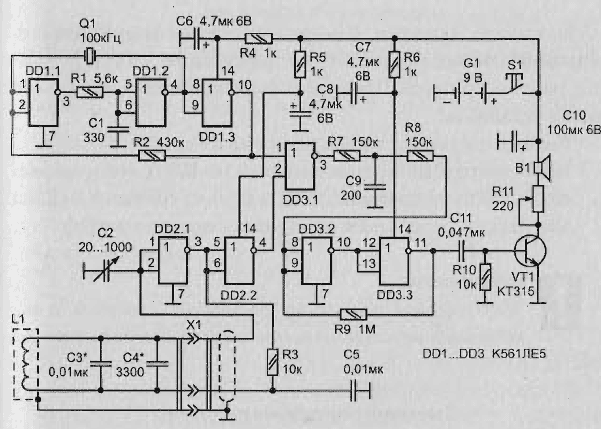The principle of action and opportunities
This detector also works on the beat. He has two removable search coils of different diameter:
- 250 mm;
- 500 mm.
By means of a first coil (250 mm) to search for small shallow located metal objects (such as a nail into a brick wall under a layer of plaster or Wallpaper).
By the second reel (500 mm) can look for more deeply located items.
For example, the drill bit 10 mm instrument observes from a distance of about 30 cm, and the hatch cover detects under 1-meter layer of snow. Coin 5 rubles (modern "penny") device with a 500 mm coil detects at a depth of 12-15 cm.
Schematic diagram of small-sized metal detector
In the scheme of the detector (Fig. 2.36) has two generators, a supporting and search. Reference oscillator is made on the chip D1, the frequency is 100 kHz, stable quartz resonator Q1.
Search generator is made on the chip D2, its oscillation frequency is about 100 kHz and is determined by the parameters of the circuit L1C2C3C4. The frequency of this circuit is highly influenced by the volumetric change in inductance of the coil L1 at a location not near metallic objects.

Fig. 2.36. Schematic diagram of small-sized metal detector
Since the metallic parts of the instrument, so they had no influence on his work, the coil must be mounted on one end of the dielectric (wood) rod length 80 cm, and the device at its other end.
The signals of the generators are summarized in the element D3.1. At the output are formed the signals sum and difference frequencies:
- the sum-frequency signal is suppressed by the circuit R7C8R8;
- the difference frequency signal (beat signal) is supplied to the Schmitt trigger, performed on the elements of D3.2, D3.3, which changes its state each time the half cycle of the input signal.
At the output of the Schmidt trigger is enabled pulse shaper elements and C9R10 transistor VT1. As a result of Schmidt's trigger and pulse shaper you can hear:
- the beating frequency from a few kilohertz;
- low-frequency beat frequency of 1-10 Hz, which are reproduced by the loudspeaker B1 as crackles (reminiscent of the sound of the crackling radiation dosimeter).
This circuit implementation allows you to hear a very small frequency deviation search generator.
Interchangeable search coil
The device works with two replaceable coils. Both coils have the same design, but of different diameter and number of turns. Reel diameter 250 mm need to be wound on the mandrel with the same diameter. Just wound 30 turns of wire sew 0,61. Then the coil should be removed from the mandrel. The resulting ring harness must tightly wrap the rope round.
Then the coil should be taped from a thin foil. Wrap the ribbon but not over the entire surface, and so that in the opposite terminals of the coil part is left unshielded portion of the length of about 10 mm. Then the coil should tightly wrap several layers of electrical tape.
In the mounting of the coil cannot be used metal parts.
The second coil has a similar structure, but its diameter is 500 mm, and the number of turns - 21, the wire is the same. For rigidity, the coil can be fixed with glued with epoxy glue the ropes on related reek of the frogs.
Element base
The capacitor C2 is three-section, air-dielectric 6-360 pF, all sections connected in parallel.
As B1 will fit any speaker.
Adjustment
The establishment is setting up the con tour L1C3C4C2 (by means of selection and C3 C4) so that when the middle position S2 it was possible to achieve a very low pitch sound, rolling in rare crackles.
Author: V. Korotkov






